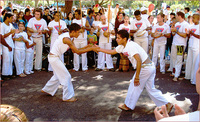Monthly Archives: September 2010
Financial journal in Brazil highlights the work of Pedro Meira and Bruno Carvalho
Há dois anos, o endereço profissional da professora de literatura
brasileira Marília Librandi Rocha ficava em Vitória da Conquista, na
Universidade Estadual do Sudoeste da Bahia (Uesb). Desde janeiro de
2009, Marília atende em sua sala na Universidade de Stanford, na
Califórnia. Se no interior do Brasil se sentia imersa numa realidade
difícil, de repente viu-se transportada para uma situação bem diferente:
tornou-se a maior referência do país para seus alunos e colegas
americanos. “Sou a única representante do Brasil aqui”, conta Marília,
por telefone. Doutora em literatura comparada na Universidade de São
Paulo (USP), ela trabalhou quatro anos na Uesb até ser convidada por
Stanford.
Mario Vargas Llosa in Princeton
 Mario Vargas Llosa, one of the most important contemporary authors, will be spending the fall semester in Princeton. He will be teaching a seminar on Borges for PLAS and a creative writing workshop for the Lewis Center. On October 11, at 7:30 pm, he will give a public lecture in Richardson Auditorium.
Mario Vargas Llosa, one of the most important contemporary authors, will be spending the fall semester in Princeton. He will be teaching a seminar on Borges for PLAS and a creative writing workshop for the Lewis Center. On October 11, at 7:30 pm, he will give a public lecture in Richardson Auditorium.
Robert Darnton interviews Lilia Schwarcz for the New York Review of Books
In a recent conversation about Brazilian culture, Schwarcz, who spent last semester at PLAS, said:
It is strange how nowadays Brazil has a new image coming from abroad. We used to be seen as “exotics”; a country of Capoeira (a Brazilian form of martial art), Candomblé (a syncretic African religion), Carnaval, and the “Mulatas.” Now we continue to be viewed as exotic, but the exoticism has a new ingredient: violence, even a new aesthetics of violence, mainly in the way Brazil is portrayed in contemporary films, like City of God. The fascination with favelas among many people outside Brazil is ambiguous. On the one hand, favelas are seen as violent communities, subject to violent leaders outside the authority of the state. On the other, they are just “different”–scenes of a culture outside the dominant culture, with its own special way of partying, dancing, playing soccer.

